Praxis Englandqpraxis English Language Arts Content Analysis Study Guide
Welcome to our Praxis English Language Arts Content and Analysis (5039) practice test and prep folio. On this page, we outline the domains and key concepts for the Praxis English Language Arts Content and Analysis test. It is a free resource nosotros provide so you tin see how prepared y'all are to take the official test.
While this free guide outlines the competencies and domains found on the examination, our paid Praxis ELA Content and Assay written report guide covers EVERY concept you need to know and is gear up to ensure your success! Our online Praxis ELA Content and Analysis report guide provides exam-aligned study cloth using interactive aids, videos, wink cards, quizzes and practice tests.
Will I pass using this free article? Will I pass using your paid study guide?
If you use this guide and research the fundamental concepts on the Praxis ELA Content and Assay on your ain, information technology's possible you will pass, simply why take that chance? With our paid report guide, we guarantee you will pass.
→ Subscribe At present: Praxis ELA Content and Assay Study Guide
Quick Links to Assist You Navigate This Page
- English Language Arts Content and Analysis Test Information
- Praxis 5039 Category I: Reading
- Praxis 5039 Category Ii: Linguistic communication Usage and Vocabulary
- Praxis 5039 Category Iii: Writing, Speaking, and Listening
Praxis ELA Content and Analysis Test Information
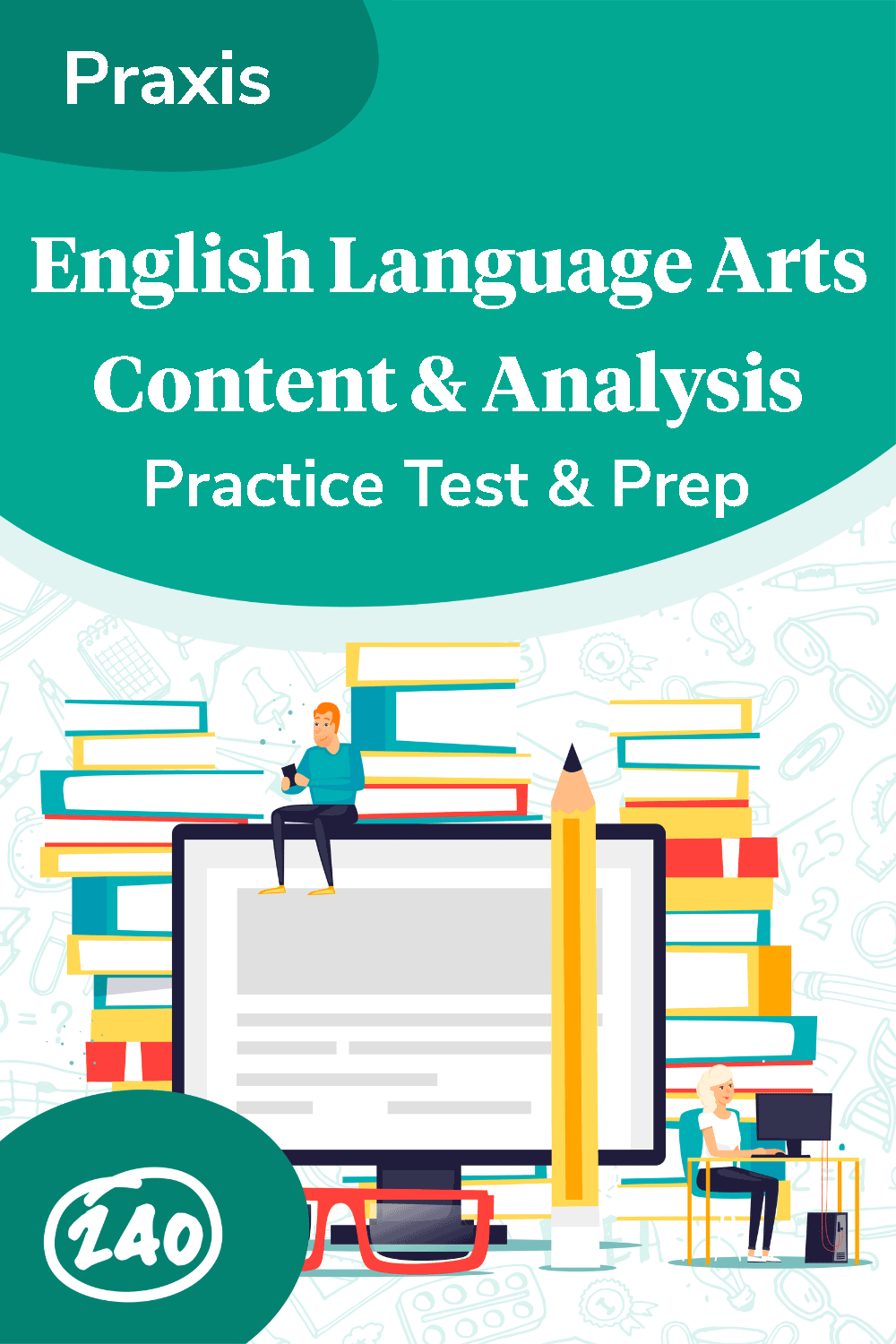 The Praxis ELA Content and Assay (5039) test measures knowledge of specific subjects that educators volition teach, besides as full general and subject-specific didactics skills and noesis.
The Praxis ELA Content and Assay (5039) test measures knowledge of specific subjects that educators volition teach, besides as full general and subject-specific didactics skills and noesis.
The test is fabricated upwardly of 130 selected-response (multiple choice) and 2 constructed-response (curt answer) questions.
- Reading: 48 selected-response questions and ane constructed-response question
- Language Use and Vocabulary: 33 selected-response questions
- Writing, Speaking, and Listening: 49 selected-response questions and 1 constructed-response question.
Y'all will take 150 minutes total for the selected-response questions, and thirty minutes for the constructed-response questions.
Cost:
The exam fee is $146.00.
Scoring:
The score range needed to pass depends on the country you are existence certified in. You lot can go to
https://world wide web.ets.org/praxis/states
and bank check for your specific certification requirements.
Study time:
You lot should fix bated time each day to devote to studying. Familiarizing yourself with the content that will be on the test will help you decide what areas you should report each day. Make sure to start studying early and allow enough time to adequately cover all areas that will be tested on the exam.
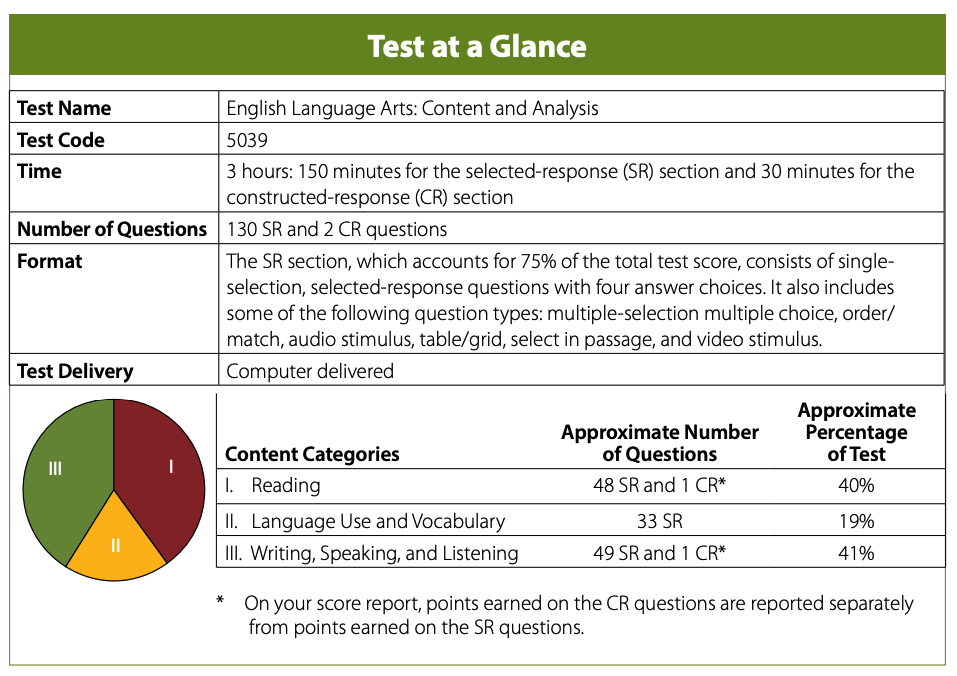
What test takers wish they would've known:
- Exam takers tend to overestimate their abilities to perform well on Praxis®️ assessments. Many students regret not putting more fourth dimension and endeavour into preparing for Praxis®️ assessments beforehand. Fortunately, it's easy to avoid this error past using exam training materials.
- Information technology's a bully strategy to rails your time while taking thetest. You can monitor your time by periodically checking the timer in the upper right-hand corner of your screen.
- Because fourth dimension management is crucial, skip questions you observe extremely difficult and movement forward to questions you find easier to answer. Don't worry, you can marking the questions y'all skip as y'all take the test. Try to stop the other questions with ten to xv minutes remaining and use that extra time to return to the more challenging questions. If y'all are unsure of an answer, it is better to approximate than to leave a question blank.
- When answering the selected-response questions, you should read all possible answers before marking the correct one. You don't want to miss out on the best answer by not reading all of the responses!
- E'er check your respond earlier moving to the next question. Many test takers are surprised by how they're able to find overlooked errors in their work by using this strategy.
Data and screenshots obtained from the ETS Praxis website.
Praxis 5039 Key Concepts to Know
Praxis 5039 Category I: Reading
This content category has 48 selected-response questions and 1 synthetic-response question. These questions account for forty% of the entire Praxis ELA Content and Analysis exam.
The Reading content category can be broken downward into two sections:
- Literature
- Advisory Texts and Listening
Literature
Let'south talk nearly a couple of specific concepts related to literature that are likely to appear on the exam.
Literary Genres
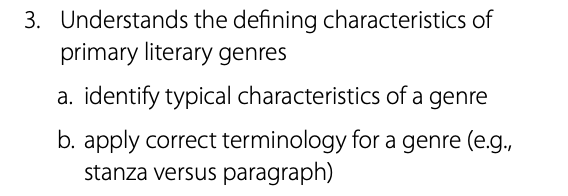
The following table defines typical characteristics and terminology of major
literary genres.

Figurative Language
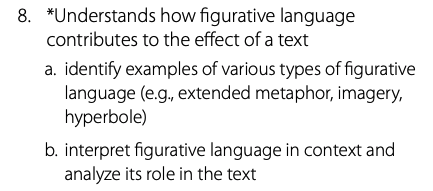
Figurative language is used in writing and speaking so that the message being conveyed is more constructive, impactful, and/or persuasive.
This topic could exist tested in the constructed-response question for this category, so it is important to be able to recognize and interpret figurative language.
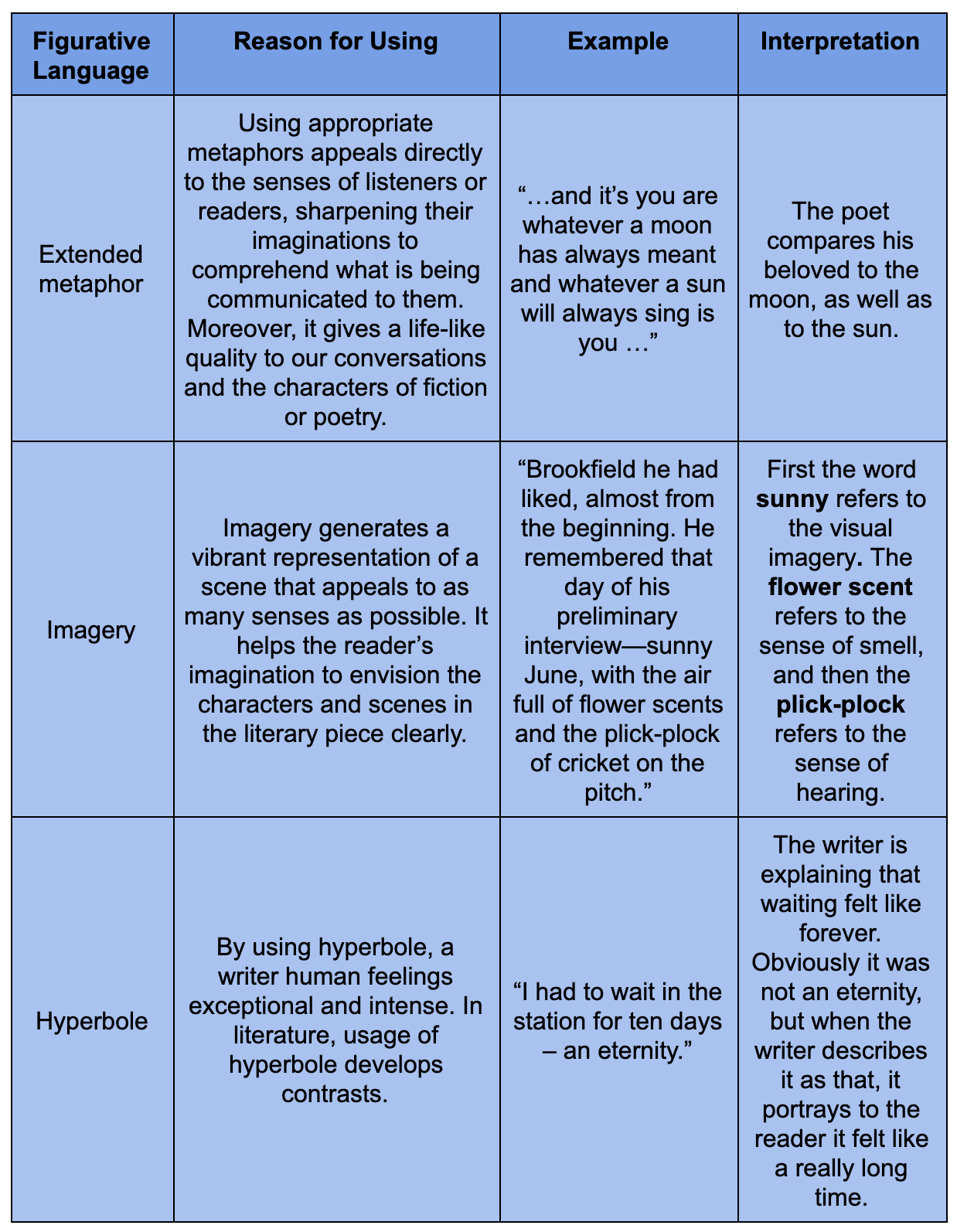
Common Strategies for Reading Education
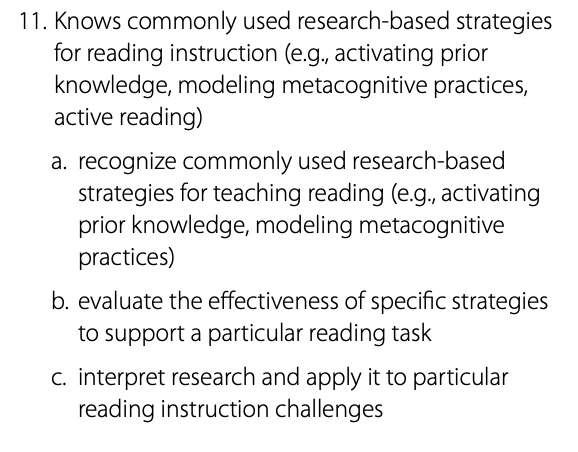
- Activating prior knowledge is of import for students to build on what they already know and make connections.
- Modeling metacognitive practices helps students know what is expected of them.
- Active reading is reading for a purpose. Students need to be taught strategies to dive deeper into the text.examples: marking texts, summarizing, rereading
- Turn and talk is used for peer to peer learning. Students are able to feel more comfy with their peers and converse with them on the text to clarify misconceptions.
- Graphic organizers are used to organize a reader's thoughts so they are able to better empathize the text.
- examples: t-nautical chart, bubble map, venn diagram
Advisory Texts and Rhetoric
Cheque out these 2 specific concepts about nonliterary texts.
Organizational Pattern of an Advisory Text
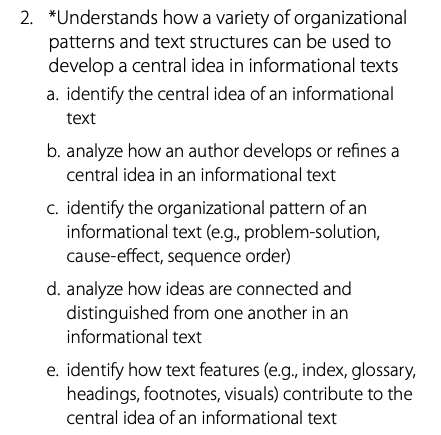
Informational text will be organized in one of 5 ways:
- Problem-solution
- Cause-effect
- Sequence order
- Description
- Compare/dissimilarity
This topic could exist measured in the constructed response-question for this category, so it is important to be able to identify organizational patterns.
Problem-Solution
Problem-solution is an organizational pattern where information in a passage is written as a problem and something was, could be, or should be done to set up the issue. This construction tin be easily confused with cause and effect, but tin be identified when y'all await specifically for a problem and solution, non just why or how something happened.
- Trouble-solution signal words: answer, advise, solution, event, problem, problematic, remedy, prevention, fix.
Cause-Effect
Cause and effect is an organizational pattern where Data in a passage is structured to describe why something happened, or the effects of something. Generally, this construction is used in expository and persuasive text.
- Crusade-effect signal words: as a result, because, caused, since, due to, resulted, result.
Sequence Club
Sequence order is an organizational pattern where a passage is organized past the lodge in which it occurs. Ordinarily this organizational pattern is used when giving instructions or directions, just it can also be used to explain diverse processes in nature or politics.
- Sequence order signal words: first, next, before, then, lastly
Clarification
The descriptive organizational pattern is used to give a detailed clarification of something so the reader gets a mental flick while reading.
- Description indicate words: depict, for instance, such as, characteristic
Compare and Contrast
Compare and contrast is a blueprint of arrangement where the similarities and differences of 2 or more than things is described. For a text to be considered a compare and contrast piece it must discuss similarities AND differences. If just similarities, or just differences are described, information technology is not truly compare and contrast.
Compare and contrast signal words: like, both, dissimilar, similar, neither, different
Rhetorical Strategies
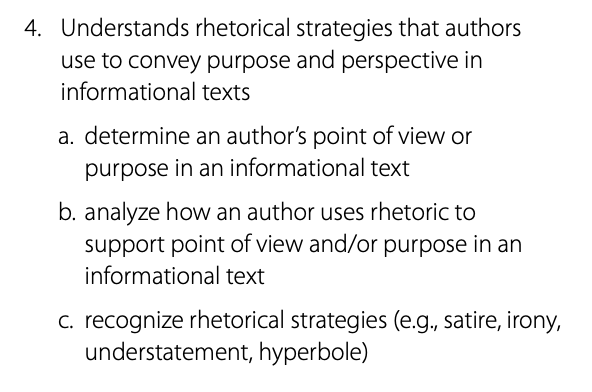
Rhetorical strategies are tools that help the author play on words to create an effect to their writing.
- Satire is the employ of humor, exaggeration, or criticism to endeavour to alter the reader's stance on an issue. An author sometimes uses information technology to influence the reader's political or social opinion.
- Irony is when the unexpected happens in a situation that is expected. Case: Raining on your wedding ceremony twenty-four hour period. Being offered a free dessert later on you've already paid for yours.
- Understatement is making something seem less important. The author might utilise an understatement to be polite or sensitive to the reader.
- Hyperbole is an exaggeration or overstatement. The author might utilize hyperbole to be more dramatic or add a level of humour to the text.
Methods of Entreatment or Persuasion

Authors utilize various methods when trying to persuade or appeal to a reader. Three of the most common are using expert opinions, generalizations, and testimonials.
- Expert opinions are typically used to try to sell a product or experience. An author will apply the word of an practiced in a given field to try to appeal to readers. For example, if an writer is trying to persuade parents to apply a new sunscreen for their child, the author could quote a pediatric dermatologist who claims their sunscreen is medically superior to other products.
- Generalizations are sweeping statements about a whole grouping, but based only on one or two members of that group. If the reader believes the generalization it tin be effective in persuading the reader, but if the writer is non believed, a generalization could actually discredit the writer. For instance, if a paper wrote an article on two teenagers stealing from a convenience store, and called for all teenagers to have stricter curfews in place considering most teenagers steal.
- Testimonials are used to typically sell a product or feel, ordinarily in ads, and are a person's written or spoken statement about a product. For example, if a glory gives a testimonial almost a new skin cream and an author uses that to try and persuade readers to also use the skin cream, it could exist more persuasive than non having the testimonial.
Praxis 5039 Category II: Language Usage and Vocabulary
This content category has 33 selected-response questions. These questions account for 19% of the unabridged test.
The Language Utilize and Vocabulary content category can be broken down into
five competencies:
- Conventions of Standard English
- Word Meaning
- Reference Materials
- Dialect and Diction
- Language Acquisition and Vocabulary Development
Let's look at each of these competencies and discuss a specific concept from
each one.
Conventions of Standard English

Judgement Structures
- Unproblematic sentences are complete thoughts that contain a subject and a verb. They are referred to as an independent clause.
- Case: The girl ran.
- Compound sentences have ii independent clauses connected past a conjunction or semicolon.
- Instance: I like running and he likes running.
- Complex sentences begin with an independent clause and have a conjunction that connects a dependent clause. The connected dependent clause does not limited a complete thought.
- Example: I missed my double-decker because I was late.
- Complex-chemical compound sentences take two independent clauses and i or more than dependent clauses connected past conjunctions.
- Example: Paul did non run in the race because he was sick and so he was disappointed.
Word Pregnant

Affixes
Affixes are 1 or more letters added to a base give-and-take to alter its meaning. If you understand the meaning of the affix information technology can help you to determine what the derivative ways.
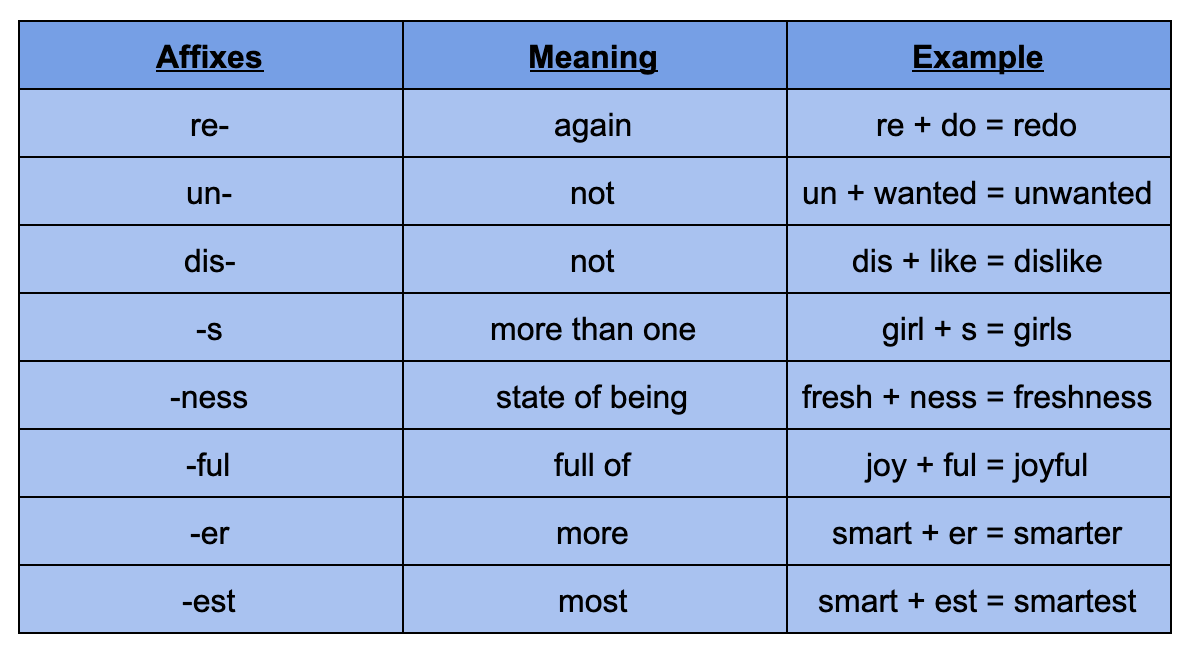
Reference Materials
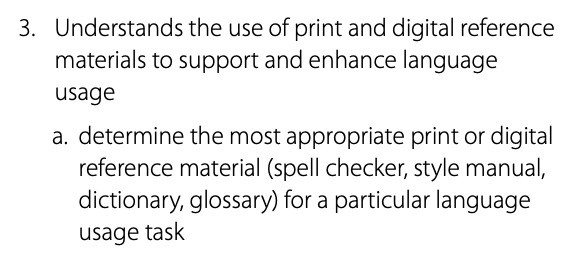
Digital Reference Materials
Digital reference materials are powerful tools to use in the classroom. It is important to educate students how to use print and digital reference materials and how to choose the appropriate reference cloth for a given task.
Common digital reference materials in the classroom include:
- Spell bank check- Spell check is a not bad tool for all students to use, and would be great for students to employ in the editing phase of their writing. There are many apps that tin can exist added to a computer and spell bank check is embedded into most give-and-take processing programs, such as MS Word.
- Manner manual- The MLA Mode Center is a bully digital reference for students who are learning to write in the MLA style. This would exist a great tool for eye and loftier school students who are tasked with writing a research paper; it is also a great tool to gear up students for writing in college.
- Dictionary- Merriam-Webster offers an online dictionary with material for all course levels. This would exist a keen tool to use when introducing vocabulary and giving students the opportunity to look up words, how they're used in sentences, parts of oral communication for the word, etc.
- Glossary- Glossaries are great points of reference for students who are looking up information. Digital glossaries can be found online past topic and could exist a swell tool for students who are gathering inquiry or wanting to learn more about a topic.
Dialect and Diction
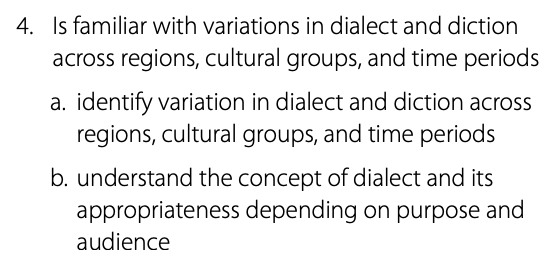
This competency tests your knowledge of dialect and diction.
Dialect
Dialect is specific to each region, cultural group, or fourth dimension period. It is the way language is expressed within a group of people that they understand. In the Usa you tin recognize where a person is from based on how they greet someone.
Example: If you live in the southward you might greet someone with a "Howdy," while in the north a simple "hello" or "hello" would be used.
Dialect can fifty-fifty exist specific to a genre of literature that is specific to the time period. For example, Shakespearean dialect ordinarily needs to exist translated into modern English to understand the text.
Language Acquisition and Vocabulary Evolution
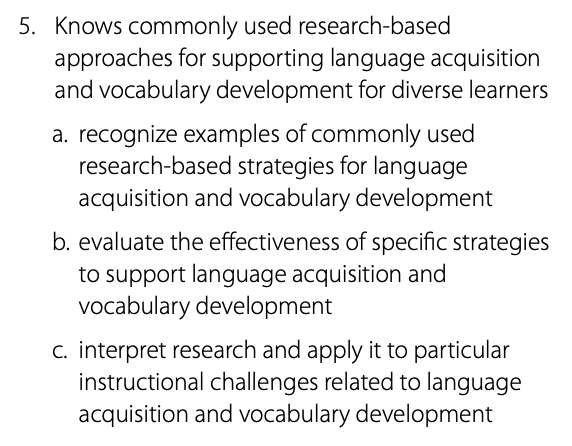
Language Development
When children develop their showtime language it is unremarkably automatic and effortless, simply 2d linguistic communication conquering takes more time. Students progress through v phases of language development.
- Pre-production has minimal comprehension and is more than reliant on nodding and pointing than exact responses.
- Early production has more than comprehension and one or two-word responses.
- Spoken language emergence has expert comprehension but makes grammatical errors and frequently does not understand the slang of peers or jokes.
- Intermediate fluency has great comprehension and makes fewer grammatical errors.
- Advanced fluency is close to the equivalency level of a native speaker.
Students should progress through each phase and receive specific back up to aid them succeed in school. When teachers provide appropriate back up for students they create a safe surroundings for students to learn and grow.
III: Writing, Speaking, and Listening
This content category has 49 selected-response questions and 1 constructed-response question. These questions business relationship for 41% of the entire exam.
The Writing, Speaking, and Listening content category tin can be broken downwards into
10 competencies:
- Modes of Writing
- Task, Purpose, and Audition
- Clear and Coherent Writing
- Inquiry Practices
- Speech communication and Presentation Delivery
- Teaching Students to Use Digital Media
- Teaching Components of Writing
- Assessing Reading, Writing, Speaking, and Listening
- Oral Advice
- Incorporating Educatee Diversity
Let'southward look at each of these competencies and hash out a specific concept from
each one.
Modes of Writing
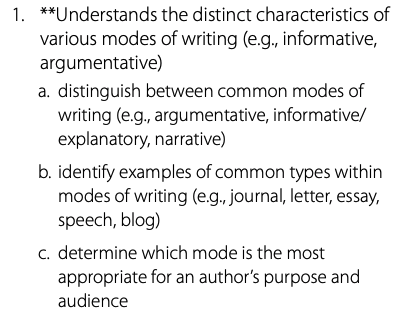
Common Modes of Writing
It is important to be able to distinguish betwixt common modes of writing (argumentative, informative/explanatory, and narrative) and to be able to recognize modes of writing in unlike text.
This competency may exist measured in the synthetic-response question for this category.
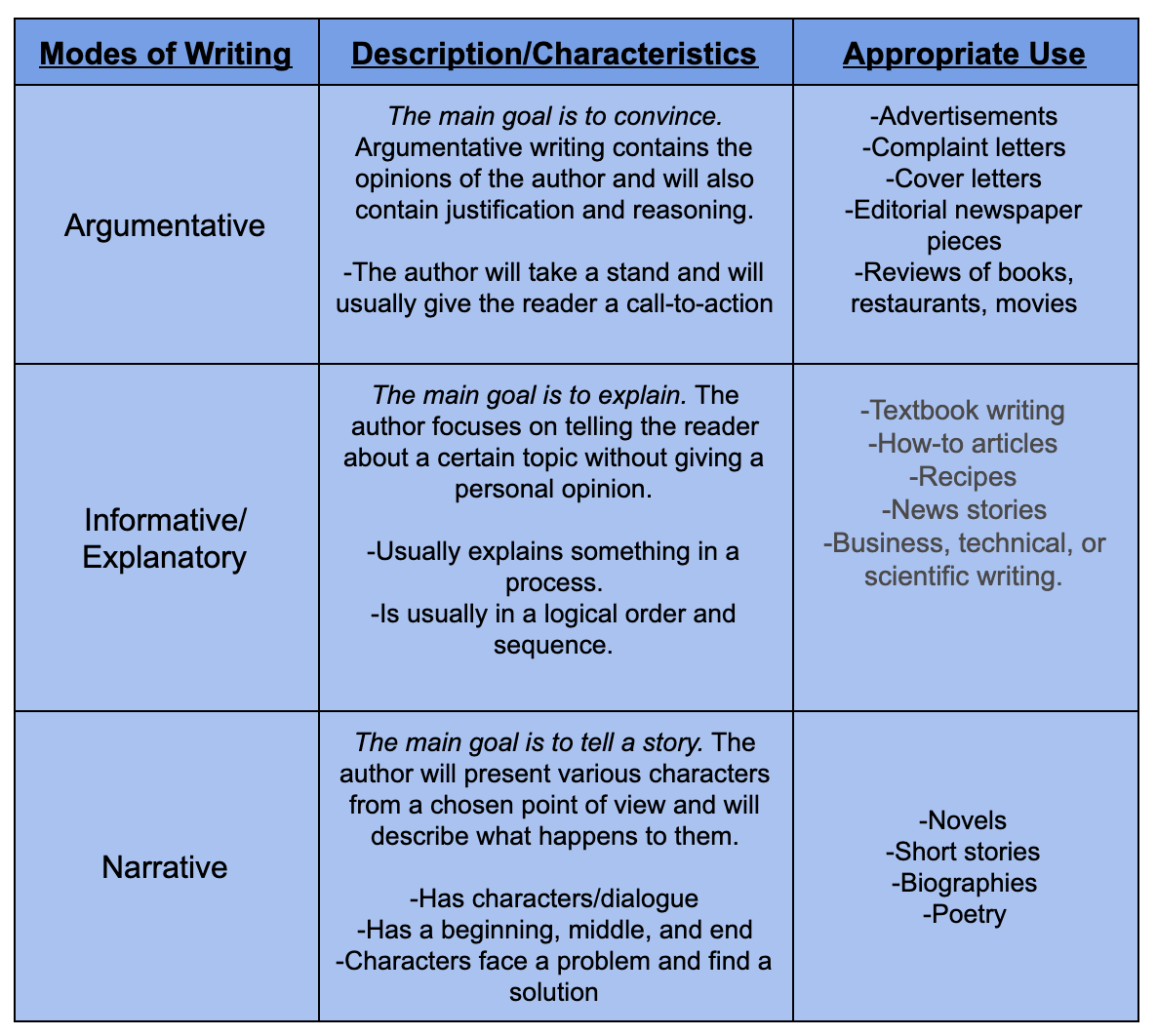
Chore, Purpose, and Audience
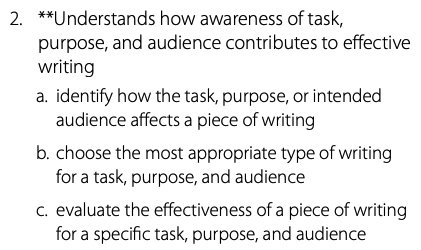
Purpose
Awareness of job, purpose, and knowing the audience all contributes to constructive writing. It is important to sympathise the author's purpose because this competency may be measured in the constructed-response question for this category.
An author'southward purpose is the reason or intent in writing. An author might write to entertain the reader, inform the reader, or persuade the reader.
Generally, an author will write to:
- Retell events or a story (narrative/entertain).
- Explicate what something looks like, feels like, sounds like (descriptive).
- Persuade a reader to believe an idea or take a specific course of action (persuasive).
- Inform or instruct the reader (expository).
At times the author's purpose is articulate, but other times information technology is more difficult to
interpret. Yet, an writer's purpose volition ever be reflected in the way he/she writes about a topic. For instance, if the writer is trying to entertain the reader he will use jokes, satire, or anecdotal stories. If the purpose is less articulate, clues can always be institute in the title of the text, prefaces, and potentially in background information about the author.
Clear and Coherent Writing
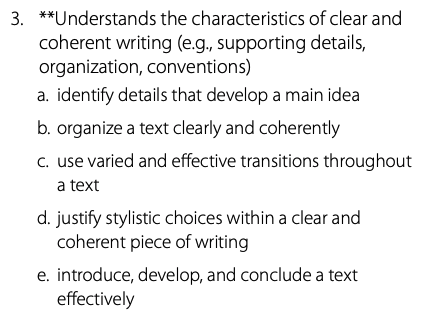
Effective Transitions
Transitions are necessary for clear and coherent writing considering they assistance establish logical connections between sentences and paragraphs in writing. Transitions assist readers understand what to do with the text and can be unmarried words, phrases, or complete sentences.
This competency may be measured in the constructed-response question for this category.

Research Practices
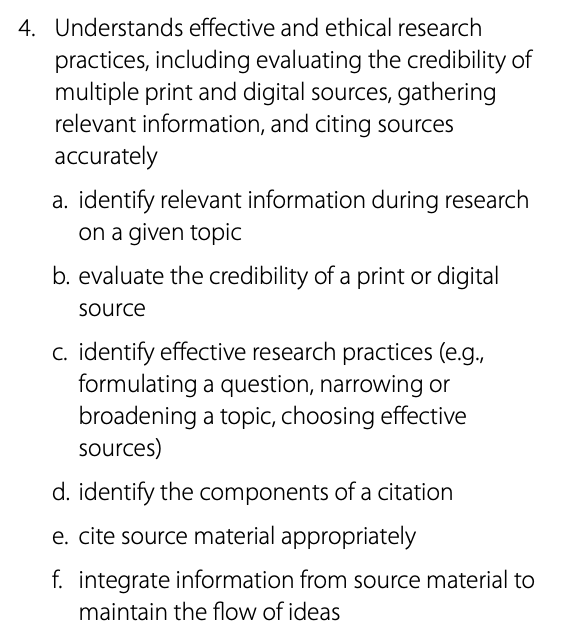
Components of a Citation
The components of a citation include the who, what, when, and where of a source.
- The Who= the writer of the source.
- The What= the title of the source.
- The When= the engagement of when the source was published.
- The Where= where the source was published or where to find information technology online.
Instance of MLA commendation:
Rowling, J. K.
Harry Potter and the Magician's Stone
. New York: Scholastic, 1999. Impress.
Speech and Presentation Commitment

Characteristics of Constructive Delivery of a Presentation
- Centre contact involves being able to read the room and look for reactions, and also being able to continue your eyes up and look the audience in the eyes.
- Visual aids could include powerpoints, videos, charts or graphs. Being able to create a visual helps the audience to run across and relate to the topic you're explaining.
- Tone creates the mood of your presentation. Being able to use your voice finer to create an appropriate tone for your presentation includes existence able to control your volume, clarity, pauses, and use emphasis when needed.
Didactics Students to Use Digital Media
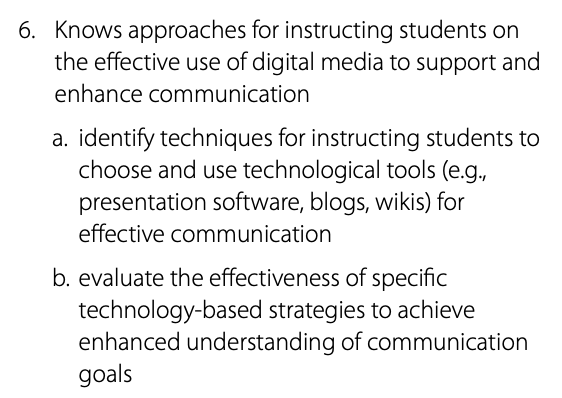
Technological Tools for Effective Communication
- Presentation software like Prezi or Microsoft Powerpoint tin can be used in the classroom to teach students how to present a topic.
- Software tin can be used in the classroom to communicate between students and parents. Examples: email, Remind 101
- Blogs can be used for students to write and respond to their peers' writing. They can besides gain information from blogs to relate to a topic.
- Wikis allow for a group of people to collaborate and create content on a specific topic. Wikis are helpful when teaching students how to collaborate during group projects.
Educational activity Components of Writing
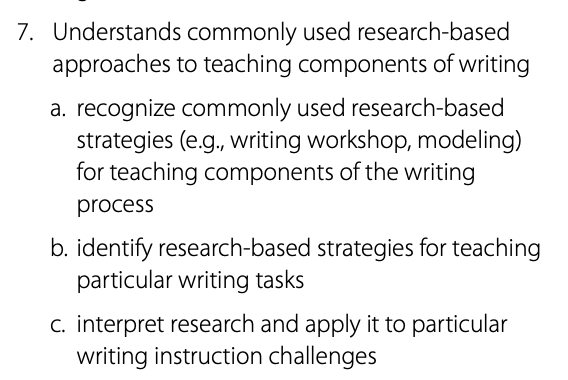
Writing Workshop
Writing workshop is designed to have students become better writers by writing. Information technology consists of iv main components.
- Mini-lesson is only about 5-10 minutes and in a whole group setting. Teachers bring students together to be direct and focus on specific writing skills. For example, it may include expectations of the writing process, the qualities of skillful writing, and editing skills.
- Writing usually lasts about 35-45 minutes and is where students are working independently on their writing and going through the writing procedure.
- Conferring happens during the independent writing fourth dimension. Teachers monitor writing around the room and use this time to pull individual students or small groups who are struggling on an area of the writing process to work with them.
- Share Time is when students choose a part or a whole piece of their writing to share with the entire class. It is a time when students learn how to accordingly respond to other'due south writing.
Assessing Reading, Writing, Speaking, and Listening
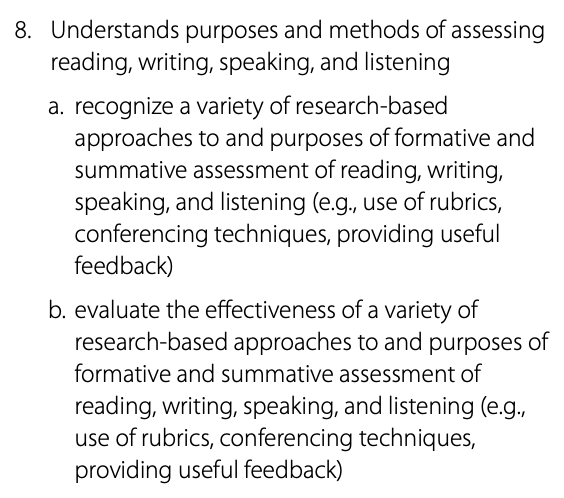
Using Rubrics to Appraise Writing
Rubrics can be used every bit a tool to assess writing in the form of research papers, projects, presentations, and portfolios. Rubrics should be provided to and discussed with all students at the beginning of an assignment and so that students know exactly what the expectations and learning goals of the consignment are. Students should know exactly what the teacher is looking for and grading, so that they have all the information necessary to demonstrate mastery. Once the assignment is complete, the teacher will apply the rubric to course each assignment, and will offering feedback on the rubric. The rubric is then returned to the educatee. A post briefing to evaluate the results is too beneficial.
Rubrics have many advantages.
Rubrics help teachers:
- Requite timely and consistent feedback to students.
- Relieve time when grading writing.
- Clarify expectations and assignment components for teachers and students.
- Plan education based on the results from the rubric score.
Rubrics help students:
- Understand and meet all expectations of an consignment.
- Ameliorate piece of work through detailed feedback from the teacher.
- Get more aware of the entire learning process.
Here is an example of a unproblematic rubric to appraise a personal narrative:

Spoken language

Agile Listening
Active listening is a very important skill for students because it is fully concentrating on what is beingness said rather than just hearing information. When students are listening actively they are listening with all senses and giving total attention to the speaker. This is a learned skill for students and can be encouraged by the instructor.
A ninth-class English language instructor is kickoff a whole grouping lesson, and needs every student'southward attention. To ensure that all of her students are actively listening she should look for :
- All students looking at her and not working on anything else.
- Remind students to not merely listen, merely to experience
the content she is presenting.
- Be sincerely interested.
- Ask students to recapitulate what she said.
- Require students to ask description questions.
- Allow students to share only Later on they accept listened.
The instructor tin encourage agile listening past encouraging/praising students who are actively listening, modeling what an active listener looks/sounds like when students are presenting, and role playing so that students understand the expectations.
Incorporating Pupil Variety
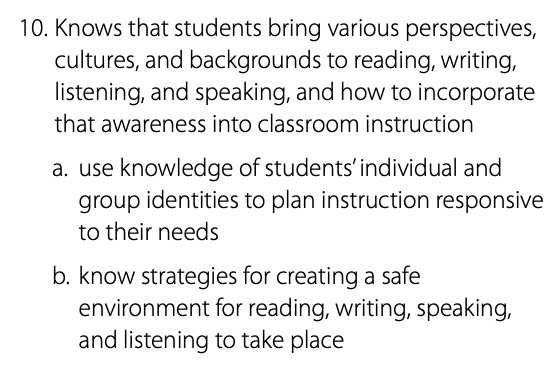
Creating a Safe Environs
Students can not acquire if they practise not feel safety. One of the most important things a instructor tin can do is constitute a safe classroom, non merely physically, but mentally and emotionally. Students must be able to write and say their thoughts likewise as listen to others while feeling safe and comfortable. Strategies to help create a rubber learning surroundings are:
- Keeping your classroom clean and organized.
- Celebrate student work in many different ways.
- Allow students to limited themselves and encourage others.
- Establish a listing of expectations/classroom commitments that details non-negotiables (no bullying, proper noun calling, etc.).
- Always stay calm and in control.
- Turn mistakes into learning opportunities.
- Model kindness and explain to students how you handle "failure" or disappointment.
- Connect with students by moving around the classroom and interacting daily.
- Provide students with as many choices every bit possible.
- Provide students with argument stems that they tin can use to respectfully agree or disagree. For example, postal service somewhere in the room statements such equally: "I hold with you considering _____________." or "I disagree with you because _____________."
And that'southward some basic info near the Praxis 5039 exam.
donnersearturefor.blogspot.com
Source: https://www.240tutoring.com/praxis-prep/praxis-english-language-arts-content-and-analysis-practice-test/
0 Response to "Praxis Englandqpraxis English Language Arts Content Analysis Study Guide"
Post a Comment